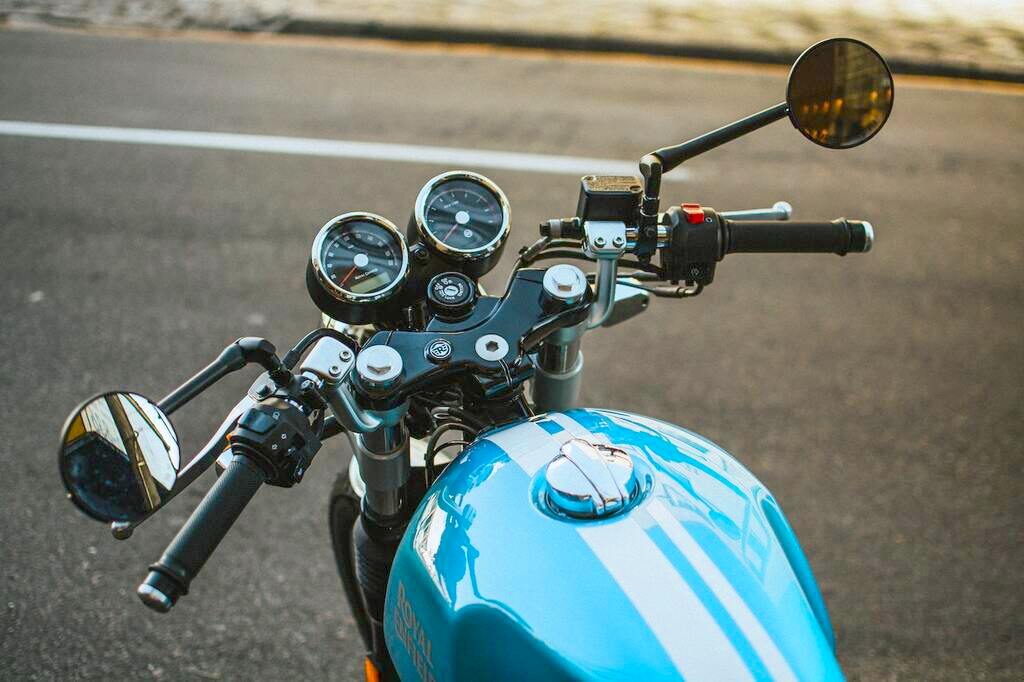Some of the links in this post are affiliate links, meaning we may get a small commission when you purchase through our links, at no extra cost to you. It helps us covering the expenses of keeping this site free for you. Thank you for your support!
We’ve all been there. Going for a ride on a sunny day only to discover later that the rear-view mirror has not been properly adjusted.
A blind spot in a bike’s rear mirror is not pleasant. It could be dangerous since all the big vehicles on the road don’t care for your small motorbike. What happens if you can’t see that approaching cargo van until it’s on your neck? Oh-dear! That’d be terrible!
Let’s find out how to avoid the blind spot in the motorbike’s rear-view mirror.
Key Takeaways
- Adjust the rear-view mirror according to your convenience
- Be careful about setting the mirrors’ mounting height
- Keep an eye on your surrounding when riding a motorbike
- Use our suggested products
DISCLAIMER: Our advice is merely guidance. It’s not a substitute for a competent instructor, nor do we have legal training.
What Is a Blind Spot in Motorcycles?
Every vehicle on the road, including motorcycles, has blind spots – areas that are difficult or impossible for the driver to see. On a motorcycle, the blind spot zone is particularly dangerous due to the lack of protective bodywork and the exposure of the rider.
The primary blind spot on a motorcycle is directly behind the rider and extends out a few car lengths. Riders cannot see this area by turning their head and looking behind them. They have to fully rotate their upper body to get a glimpse of vehicles or objects in this zone, which means things can easily be missed or noticed too late.
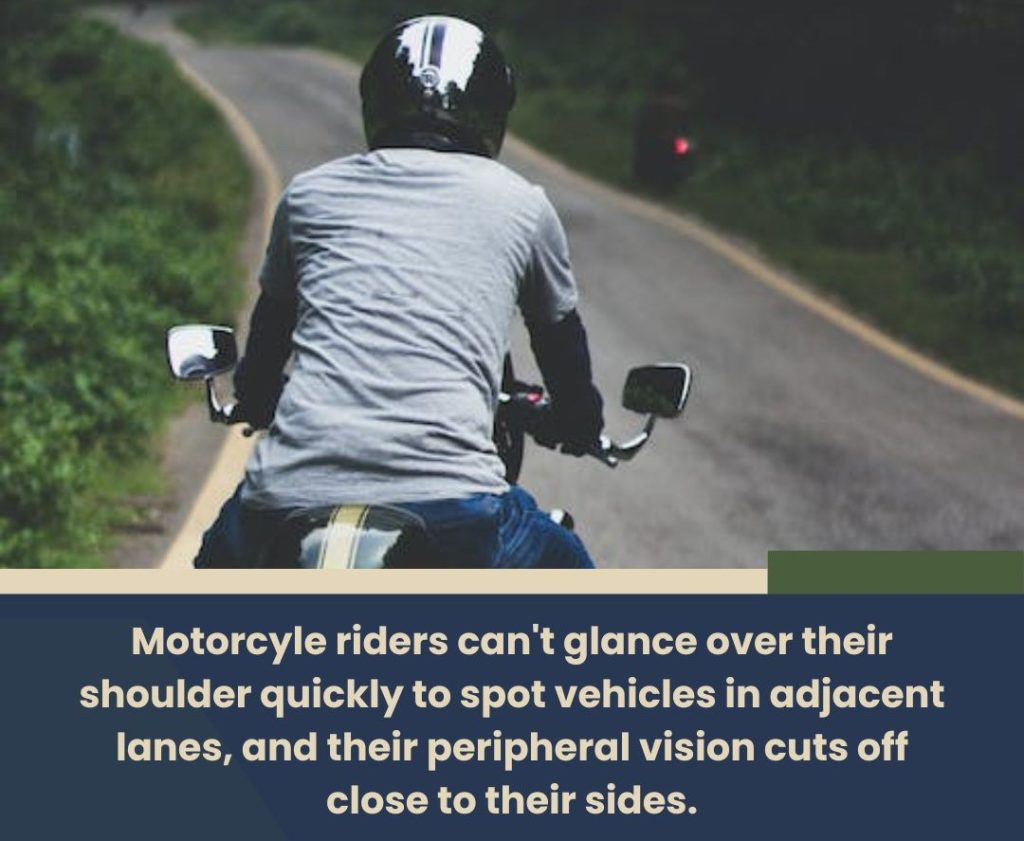
The side blind spots on a motorcycle are also significant. With a car, you have windows and pillars that can obstruct the view, but on a bike there’s nothing blocking the view, except the rider’s own helmet.
The width of the rider and the motorcycle handlebars means that vehicles or objects more than a couple of feet away from the rear corners of the bike are outside the rider’s peripheral vision.
Explaining the Blind Spot Zone (BSZ) in Motorcycles
A group of researchers identified the blind spot zone (BSZ) for motorcycles in a 2019 study.
The BSZ for motorcycles can lead to dangerous situations and accidents. There are a few reasons for this to happen:
Limited peripheral vision
Motorcycle riders have a much more limited field of view than car drivers, due to there being nothing framing their vision.
They can’t glance over their shoulder quickly to spot vehicles in adjacent lanes, and their peripheral vision cuts off close to their sides.
Reliance on mirrors
Motorcycle riders are heavily dependent on their mirrors to monitor surrounding traffic, but mirrors have blind spots and don’t give a comprehensive view of what’s around the bike.
By the time a vehicle is visible in the mirror, it may be too late for the rider to react.
Visibility challenges
Whether due to nighttime riding, dirty headlights, or clothes/helmets that obscure the rider, other drivers may struggle to see the motorcycle, especially when it’s in their own blind spot zones. And if the rider can’t easily see the vehicle that can’t see them, a dangerous situation arises.
The key things motorcycle riders and car drivers can do are:
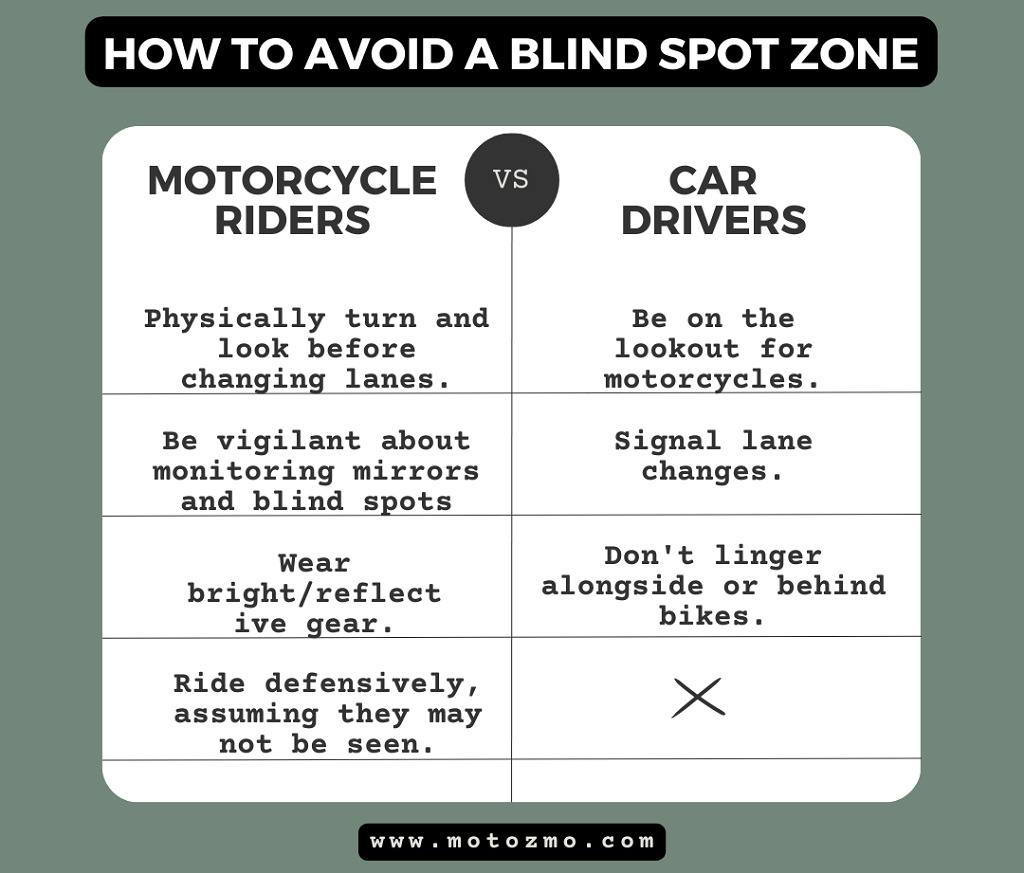
With everyone proactively taking steps to address limited vision and visibility, we can hopefully reduce motorcycle accidents stemming from blind spot zones.
How Do I Avoid a Blind Spot in a Motorbike’s Rear Mirror?
In most cases, the blind spot issue arises because of the mirror’s height mis-adjustment or a problem with its mounting on the handlebar. Let’s discuss the best practices for avoiding this problem.
1. Adjust the mirrors properly
If you can see your shoulders in the mirrors, they’re not positioned correctly. You need to adjust them so you can see as much of the road behind you as possible without looking over your shoulders.
It will allow you to see what’s happening in the lane next to you and keep an eye on vehicles trying to overtake your bike.
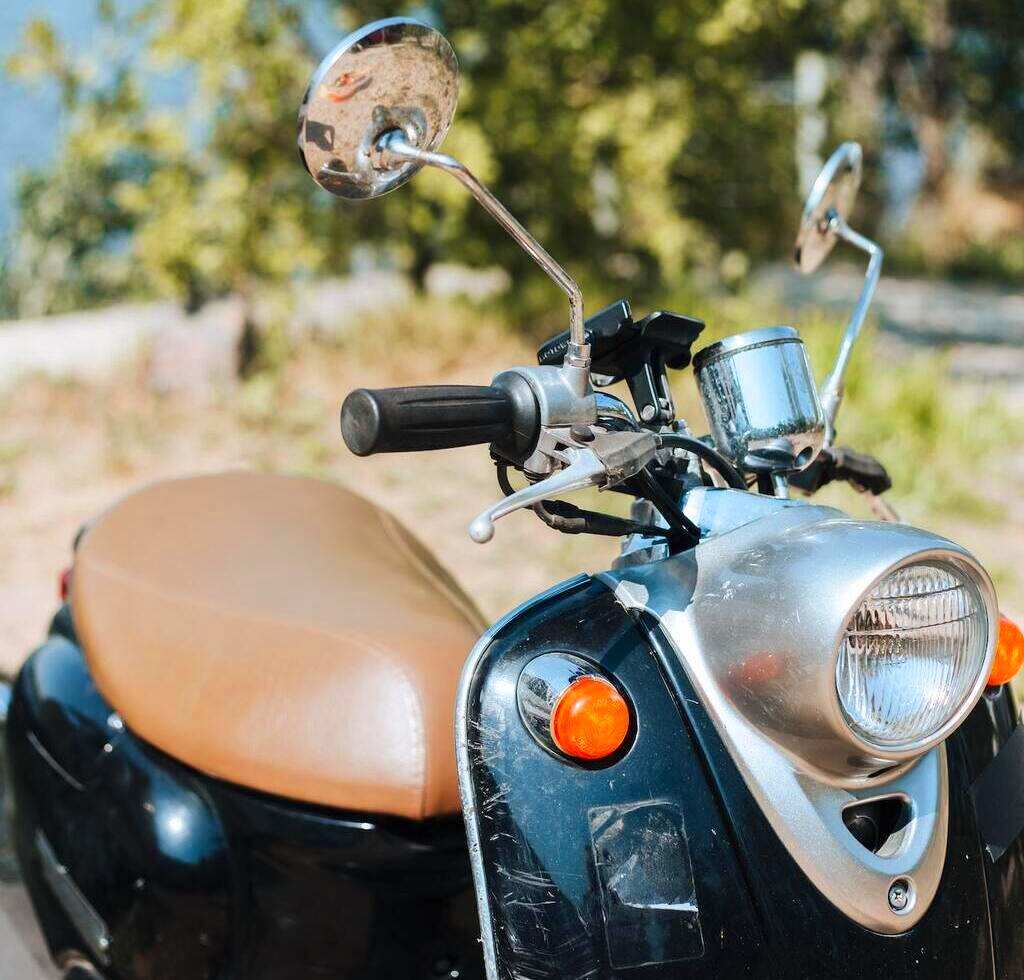
2. Check the mirror’s mounting height
The most common cause of a blind spot is the motorcycle’s mirrors being mounted too high up on the handlebars. When you’re riding with the mirrors in the highest position, you can’t see the area behind the bike—and that’s where most accidents happen. The good news is that you can avoid this problem by mounting the mirrors a little lower on the handlebar.
Some riders like to have the mirrors mounted as far forward on the handlebar as possible, while others prefer to keep them mounted closer to the rider. It’s a matter of personal preference and comfort, so experimentation is the best way to find what works best for you.
Follow this video to learn how to correctly install the rear-view mirrors in a motorcycle.
3. Don’t get fixated on what’s behind you
It may seem counterintuitive, but you can’t get fixated on what’s back there for your safety. You shouldn’t spend too much time looking in your mirrors because it can cause a momentary lapse in concentration. As a result, you may find it harder to properly judge what’s happening around you.
The point of keeping an eye on the road and other traffic around you is that it helps reduce the risk of a collision by ensuring you’re aware of everything happening around your motorcycle.
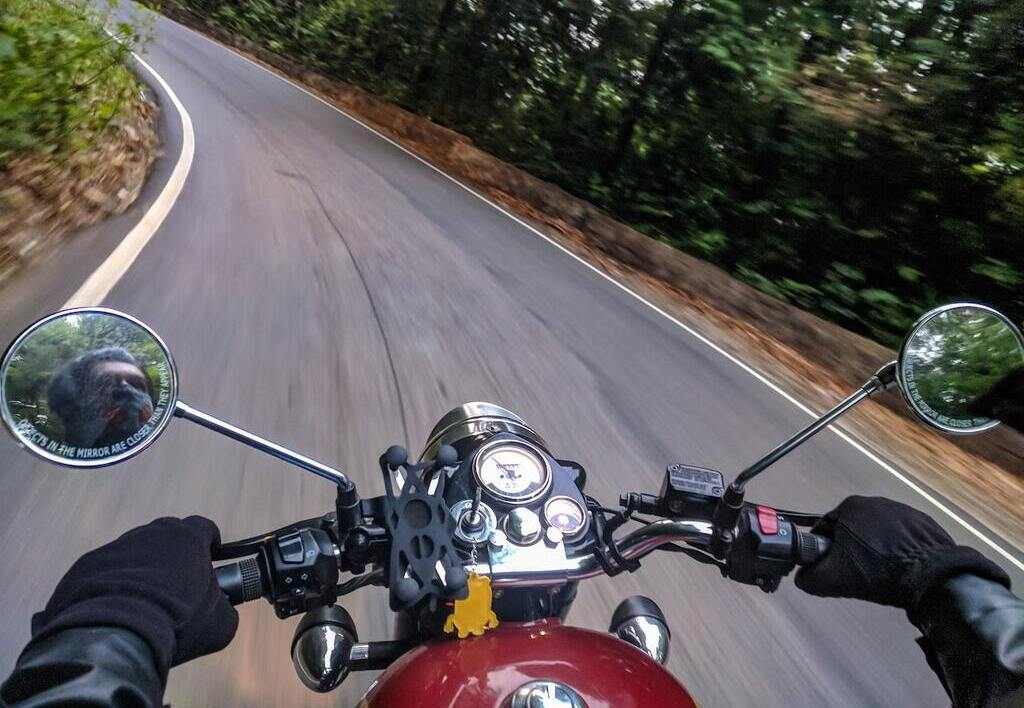
4. Don’t rely on your mirrors too much
The blind spot is the area behind and to either side of your bike that you can’t see clearly in your mirrors. It is essential to know where the blind spots are so that you can look over your shoulder at these areas, but there will always be a small space that you cannot see – no matter how good your mirrors are.
You need to use head checks and mirror checks to ensure nothing has sneaked up on you. Use your instinct and diving expertise to make sure you aren’t going to hit something or someone when changing lanes.
RELATED: 5 Reasons to Wear Armored Pants When Riding Motorcycles
Best Products for Motorcycle Blind Spot Detection
If you are too worried about blind spots while riding your bike, we suggest using any of these two products.
1
ThirdEYE Motorcycle Blind Spot System with Voice and Indicators Alert

🎯What We Love
- Wide 150-degree detection angle covers blind spots
- Can track up to 64 targets simultaneously within 50m range
- Works in extreme cold (-40°C) and hot (80°C) conditions
- Straightforward installation on many motorcycle models
⛔Things To Consider
- Audio alert can be overly sensitive at low speeds
- Requires excessive force to silence audio warning tones
The ThirdEYE Blind Spot Detection system from INNOVV is a fantastic addition to any motorcycle. It helps increase rider awareness and safety by alerting you to vehicles in your blind spots through audio and visual cues.
On the positive side, the system has an incredibly wide 150-degree detection angle that covers those tricky blind spot areas.
It is highly sensitive, able to pick up fast moving vehicles and even weak signals. This gives riders more reaction time when vehicles are approaching rapidly.
The 77-79GHz sensor is extremely precise, accurately calculating speed differentials between vehicles to provide timely collision warnings.
Another major plus is the ability to track up to 64 targets simultaneously within a 50 meter range. This is invaluable in complex traffic situations where there are many potential hazards.
The system is also built tough with IP67 waterproof and dustproof ratings, functioning well in any weather from frigid -40°C to scorching 80°C conditions.
Installation seems straightforward for most motorcycles. Several reviewers noted easy setup on BMW models like the R1200RT and GS. The radar unit mounts cleanly and the displays integrate nicely with the dash.
On the downside, some mentioned the audio alert can be overly sensitive at low speeds, though it works perfectly on the highway.
There were also comments that the button requires excessive pressure to silence the audio warning tones.
While not perfect, the ThirdEYE system is an excellent blind spot detection aid that can significantly improve situational awareness and rider safety. The wide field of view, precision tracking, harsh environment capabilities, and simple installation make it a wise investment for motorcycle enthusiasts.
2
KiWAV motorcycle 79GHz BSD LCA blind spot detection system

🎯What We Love
- Radar sensors detect vehicles approaching or in blind spots
- increases the rider’s awareness of surrounding traffic and road conditions
- Easy to install
⛔Things To Consider
- Expensive
- Limited range
As a motorcycle rider, I’m always concerned about vehicles in my blind spots – those areas on either side of the bike that are impossible to see by glancing over my shoulder or looking in my mirrors. The KiWAV Blind Spot Detection system is a brilliant solution to this problem and could be a lifesaver for riders.
The system uses radar sensors mounted near the license plate to detect vehicles approaching or in your blind spots. When it senses a vehicle entering the 30-foot range of your blind spot, an LED indicator near your mirror will light up to alert you.
This gives you crucial seconds to react and avoid a dangerous situation.
However, while 30 feet of range covers typical blind spots, very wide vehicles or those moving at high speeds could be within a rider’s blind spot beyond 30 feet, so the system’s range limitations would need to be kept in mind.
The indicators are designed to attach securely near your mirror mounts and the system draws power from your bike’s battery, so no charging is required.
Installation seems straightforward, taking under an hour for most bikes, so you could have it up and running right away. To me, the potential risks of a blind spot encounter far outweigh the minimal time and cost required to equip your motorcycle with blind spot detection. I would feel considerably more at ease riding with this system monitoring the road around me and alerting me to hazards I can’t see.
However, the system does add an additional cost to purchasing/operating a motorcycle. The upfront and installation costs would need to be considered in the purchasing decision.
If you want cutting-edge motorcycle safety technology and peace of mind on the road, the KiWAV Blind Spot Detection system is worth a serious look.
Final Words
It’s important to be aware of your blind spot when riding a motorcycle and to take precautions to avoid accidents. Paying attention to your surroundings and using your mirrors properly can help keep yourself and other riders safe on the road.
If you follow these tips, you’ll reduce the likelihood of a blind spot causing an accident.
FAQs about Motorbike’s Rear-View Mirror Blind Spot
What causes blind spot in a motorbike’s rearview mirror?
The rearview mirror’s design causes a blind spot directly behind the bike where the mirror cannot see. The mirror has a limited field of view due to its shape and position.
Is the blind spot dangerous while riding?
Yes, the blind spot poses a safety hazard while riding. Vehicles can enter the blind spot unnoticed, putting bikers at risk of rear-end collisions. Bikers must constantly check their mirrors and turn their heads to look behind them.
How can I reduce the blind spot while riding?
You can reduce the blind spot by installing extended rearview mirrors to widen your field of view. Riding techniques like frequent mirror checking, head turning, and shoulder checks can also help you detect vehicles in the blind spot area.
Do blind spot cameras or monitors help?
Blind spot cameras and rearview monitors can be very helpful by eliminating the blind spot. They give motorcyclists an unobstructed view of the entire area behind the bike. However, they are an added cost and require proper installation.
What should I look for when buying new motorcycle mirrors?
Consider convex or aspherical mirrors that reduce blind spots significantly. Open design with large reflective surface provides good visibility. Durable materials and adjustability are important. LED turn signal capability is a useful feature. Check mirror vibration at high speeds.

